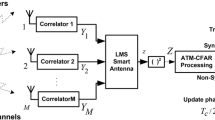Abstract
A hybrid PN-code acquisition scheme is proposed and studied for direct sequence code division multiple access communications in frequency-selective Rayleigh fading channels. The most important feature of the proposed system is its ability to dynamically estimate the number of multipath signals that may lie in the reference channel. The basic idea of the considered algorithm is to sort the partial correlations and carry out successive censoring tests by updating the noise estimation until the first path synchronization. Exact expressions for the probability of false alarm and the mean acquisition time are derived. The performances of the proposed system are then studied and compared with those of the adaptive hybrid acquisition processor (AHAP) and the ordered statistic hybrid acquisition processor (OSHAP). The effects of various channel parameters on the acquisition performance, namely the number of resolvable paths, the multipath intensity profile and the signal-to-noise ratio are also investigated. Numerical results show that the proposed acquisition scheme outperforms the conventional ones which are based on AHAP and OSHAP algorithms.
Similar content being viewed by others
Abbreviations
- AHAP:
-
Adaptive hybrid acquisition processor
- OSHAP:
-
Ordered statistic hybrid acquisition processor
- DS-CDMA:
-
Direct sequence code division multiple access
- PN:
-
Pseudo-noise
- P fa :
-
Probability of false alarm
- OSAP:
-
Order statistic acquisition processor
- AAP:
-
Adaptive acquisition processor
- ACAP:
-
Automatic censoring acquisition processor
- HAPAC:
-
Hybrid Acquisition Processor based on Automatic multipath Cancellation
- AWGN:
-
Additive white Gaussian noise
- MIP:
-
Multipath intensity profile
- pdf:
-
Probability density function
- MGF:
-
Moment generating functions
- Res:
-
The residue
References
Torrieri D. (2005) Principles of spread-spectrum communication systems. Springer, New York
Polydoros A., Weber C.L. (1984) A unified approach to serial search spread spectrum code acquisition—Part 1 and 2. IEEE Transactions on Communications, 32(5): 542–560
Tantaratana S., Lam A. W., Vincent P. J. (1995) Noncoherent sequential acquisition of PN sequences for DS/SS communications with/without channel fading. IEEE Transactions on Communication 43(4): 1738–1745
Yang L. L., Hanzo L. (2001) Serial acquisition of DS-CDMA signals in multipath fading mobile channels. IEEE Transactions on Vehicular Technology 50(2): 617–628
Shin O. S., Lee K. B. (2001) Utilization of multipaths for spread-spectrum code acquisition in frequency-selective Rayleigh fading channels. IEEE Transactions on Communication 49(4): 734–743
Sourour E. A., Cupta S. C. (1990) Direct-sequence spread-spectrum parallel acquisition in a fading mobile channel. IEEE Transactions on Communication 38(7): 992–998
Rick R. R., Milstein L. B. (1997) Parallel acquisition of spread-spectrum signals with antenna diversity. IEEE Transactions on Communication 45(8): 903–905
Rick R. R., Milstein L. B. (1997) Parallel acquisition in mobile DS-CDMA system. IEEE Transactions on Communication 45(11): 1466–1476
Zhuang W. (1996) Noncoherent hybrid parallel PN code acquisition for CDMA mobile communications. IEEE Transactions on Vehicular Technology 45(4): 643–656
Jinatti J. H. (2000) On the threshold setting principles in code acquisition of DS-SS signals. IEEE Journal on Selected Area in Comunications 18(1): 62–72
Kim C. J., Hwang T. W., Lee H. J., Lee H. S. (1997) Acquisition of PN code with adaptive threshold for DS/SS communications. IEE Electronics Letters 33(7): 1352–1354
Oh H. S., Lim C. H., Han D. S. (2002) Adaptive hybrid PN acquisition with antenna diversity in DS-CDMA systems. IEICE Transactions on Communications E 85(B(4): 716–722
Oh H. S., Han D. S. (2005) An adaptive double-dwell PN code acquisition system in DS-CDMA communications. Signal Processing 85(12): 2327–2337
Kim C. J., Lee H. J., Lee H. S. (1998) Adaptive acquisition of PN sequences for DS/SS communications. IEEE Transactions on Communications 46(8): 993–996
Kim C. J. (2002) Adaptive acquisition of PN code in multipath fading mobile channels. Electronics Letters 38(2): 135–137
Kim C. J., Lee D. D., Hwang T. W., Lee H. J., Lee H. S. (1998) Adaptive hybrid acquisition of PN sequences for DS/SS communications. Electronics Letters 34(10): 939–940
Hacini, L., Farrouki, A., & Hammoudi, Z. (2007, June). Hybrid acquisition scheme of PN codes using order statistics-based detection and antenna diversity. In Proceedings of WDD2007, Pisa, Italy (pp. 42–45).
Aissaoui A., Hammoudi Z., Farrouki A. (2008) Adaptive pseudo-noise code acquisition scheme using automatic censoring for DS/SS communication in frequency-selective Rayleigh fading channel. IET Communications 2(2): 359–365
Himonas S. D., Barkat M. (1992) Automatic censored CFAR detection for nonhomogeneous environments. IEEE Transactions on Aerospace and Electronic Systems 28(1): 286–304
Farrouki A., Barkat M. (2005) Automatic censoring CFAR detector based on ordered data variability for nonhomogeneous environments. IEE Proceedings Radar Sonar Navigation 125(2): 43–51
Proakis J. G. (1995) Digital communications (3rd ed.). McGraw-Hill, New York
Hou X. Y., Morinaga N., Namekawa T. (1987) Direct evaluation of radar detection probabilities. IEEE Transactions on Aerospace and Electronic Systems 23(4): 418–423
David H. A. (1981) Order statistics. Wiley, New York
Papoulis A. (1965) ‘Probability, random variables and stochastic processes. McGraw-Hill, New York
Viterbi A. J. (1995) CDMA: Principles of spread spectrum communication. Addison-Wesley, Reading, MA
Author information
Authors and Affiliations
Corresponding author
Additional information
This work is originally presented in ACTEA 2009, July 15–17, 2009. Notre Dame University, Zouk Mikael, Lebanon.
Rights and permissions
About this article
Cite this article
Hacini, L., Farrouki, A. & Hammoudi, Z. Adaptive Hybrid Acquisition of PN Sequences Based on Automatic Multipath Cancellation in Frequency-Selective Rayleigh Fading Channels. Wireless Pers Commun 63, 147–166 (2012). https://doi.org/10.1007/s11277-010-0112-7
Published:
Issue Date:
DOI: https://doi.org/10.1007/s11277-010-0112-7




